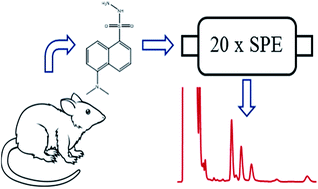Reactive aldehyde species are important byproducts of lipid peroxidation and oxidative stress due to their role in the secondary damage caused by traumatic events such as epileptic seizures and brain injury. In this study, a liquid chromatography/fluorescence method was developed to determine 4-hydroxynonenal, acrolein, and malondialdehyde in urine samples. These analytes react with dansylhydrazine to produce fluorescent dansyl derivatives with experimentally determined excitation and emission wavelengths of 250 and 550 nm, respectively, which were dependent on the organic composition of the mobile phase. Using a solid-phase extraction pre-concentration method prior to LC-FL resulted in limits of detection ranging from 6 nM to 200 nM for the three compounds. This method was then demonstrated for the detection of the compounds in urine samples. The method was then applied to the analysis of rat urine samples obtained following a chemically induced seizure. A statistically significant increase in acrolein concentration was observed. There was no change in 4-hydroxynonenal concentration, and the results for malondialdehyde were inconclusive. The method will be applied in the future to monitor lipid oxidation in different brain regions using microdialysis sampling during epileptic seizures.
